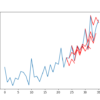Long Short-Term Networks or LSTMs are a popular and powerful type of Recurrent Neural Network, or RNN. They can be quite difficult to configure and apply to arbitrary sequence prediction problems, even with well defined and “easy to use” interfaces like those provided in the Keras deep learning library in Python. One reason for this […]










